Torque Teno Sus Virus 1: A Potential Surrogate Pathogen to Study Pig-Transmitted Transboundary Animal Diseases
Abstract
:1. Introduction
2. Materials and Methods
2.1. Field and Laboratory Protocols
2.2. Sequence Analyses
2.3. Population Analyses
2.3.1. Prevalence and Hot Spots of TTSuV1 Infections among Wild Pigs
2.3.2. Persistence of TTSuV1 Infection
2.3.3. TTSuV1 Infection and Body Condition of Wild Pigs
2.3.4. Genetic Divergence of TTSuV1 over Space
2.4. Phylogenetic Analysis
2.5. Host Relatedness and Viral Transmission: A Case Study at ABIR
2.5.1. Host Genotyping Data
2.5.2. Construction of Host Relatedness Matrix and Genetic Distance Matrix
2.5.3. Correlation Analysis of Genetic Distance Matrices of Hosts and Viruses
2.5.4. Inference of Host-To-Host Viral Transmission
3. Results
3.1. Prevalence and Hot Spots of TTSuV1 Infections among Wild Pigs
3.2. Persistence of TTSuV1 Infection
3.3. Co-Infections
3.4. TTSuV1 Infection and Body Condition of Wild Pigs
3.5. Genetic Divergence of TTSuV1 over Space
3.6. Phylogenetic Analysis
3.7. Case Study: Host Relatedness and Virus Transmission at ABIR
3.7.1. Correlation of Genetic Distance Matrices of Hosts and Viruses
3.7.2. Inference of Host-To-Host Viral Transmission
4. Discussion
4.1. Evaluation of TTSuV1 as a Surrogate TAD
4.2. A Molecular Epidemiological Case Study
Supplementary Materials
Author Contributions
Funding
Institutional Review Board Statement
Informed Consent Statement
Data Availability Statement
Acknowledgments
Conflicts of Interest
References
- Drew, T.W. The emergence and evolution of swine viral diseases: To what extent have husbandry systems and global trade contributed to their distribution and diversity? OIE Rev. Sci. Tech. 2011, 30, 95–106. [Google Scholar] [CrossRef] [PubMed]
- Beltran-Alcrudo, D.; Falco, J.R.; Raizman, E.; Dietze, K. Transboundary spread of pig diseases: The role of international trade and travel. BMC Vet. Res. 2019, 15, 64. [Google Scholar] [CrossRef]
- Weaver, T.; Habib, N. Evaluating Losses Associated with African Swine Fever in the People’s Republic of China and Neighboring Countries; The Asian Development Bank: Manila, Philippines, 2020. [Google Scholar] [CrossRef]
- Meuwissen, M.P.M.; Horst, S.H.; Huirne, R.B.M.; Dijkhuizen, A.A. A model to estimate the financial consequences of classical swine fever outbreaks: Principles and outcomes. Prev. Vet. Med. 1999, 42, 249–270. [Google Scholar] [CrossRef] [PubMed]
- Thompson, D.; Muriel, P.; Russell, D.; Osborne, P.; Bromley, A.; Rowland, M.; Creigh-Tyte, S.; Brown, C. Economic costs of the foot and mouth disease outbreak in the United Kingdom in 2001. OIE Rev. Sci. Technol. 2002, 21, 675–687. [Google Scholar] [CrossRef] [PubMed]
- Cowled, B.; Garner, G. A review of geospatial and ecological factors affecting disease spread in wild pigs: Considerations for models of foot-and-mouth disease spread. Prev. Vet. Med. 2008, 87, 197–212. [Google Scholar] [CrossRef]
- Siembieda, J.L.; Kock, R.A.; McCracken, T.A.; Newman, S.H. The role of wildlife in transboundary animal diseases. Anim. Health Res. Rev. 2011, 12, 95–111. [Google Scholar] [CrossRef]
- Pepin, K.M.; Borowik, T.; Frant, M.; Plis, K.; Podgórski, T. Risk of African swine fever virus transmission among wild boar and domestic pigs in Poland. Front. Vet. Sci. 2023, 10, 1295127. [Google Scholar] [CrossRef]
- Miller, R.S.; Sweeney, S.J.; Slootmaker, C.; Grear, D.A.; Di Salvo, P.A.; Kiser, D.; Shwiff, S.A. Cross-species transmission potential between wild pigs, livestock, poultry, wildlife, and humans: Implications for disease risk management in North America. Sci. Rep. 2017, 7, 7821. [Google Scholar] [CrossRef]
- Cleveland, C.A.; Haynes, E.; Callaghan, K.C.; Fojtik, A.; Coker, S.; Doub, E.; Brown, V.R.; Majewska, A.A.; Yabsley, M.J. Distribution and prevalence of antibodies to Trichinella spp. and Toxoplasma gondii in wild pigs (Sus scrofa) in the United States. Vet. Parasitol. 2024, 325, 110090. [Google Scholar] [CrossRef]
- Bevins, S.N.; Pedersen, K.; Lutman, M.W.; Gidlewski, T.; Deliberto, T.J. Consequences associated with the recent range expansion of nonnative feral swine. Bioscience 2014, 64, 291–299. [Google Scholar] [CrossRef]
- Pepin, K.M.; Brown, V.R.; Yang, A.; Beasley, J.C.; Boughton, R.; VerCauteren, K.C.; Miller, R.S.; Bevins, S.N. Optimising response to an introduction of African swine fever in wild pigs. Transbound. Emerg. Dis. 2022, 69, e3111–e3127. [Google Scholar] [CrossRef] [PubMed]
- Sinclair, R.G.; Rose, J.B.; Hashsham, S.A.; Gerba, C.P.; Haase, C.N. Criteria for selection of surrogates used to study the sate and control of pathogens in the environment. Appl. Environ. Microbiol. 2012, 78, 1969–1977. [Google Scholar] [CrossRef] [PubMed]
- Archie, E.A.; Luikart, G.; Ezenwa, V.O. Infecting epidemiology with genetics: A new frontier in disease ecology. Trends Ecol. Evol. 2009, 24, 21–30. [Google Scholar] [CrossRef] [PubMed]
- Grenfell, B.T.; Pybus, O.G.; Gog, J.R.; Wood, J.L.N.; Daly, J.M.; Mumford, J.A.; Holmes, E.C. Unifying the Epidemiological and Evolutionary Dynamics of Pathogens. Science 2004, 303, 327–332. [Google Scholar] [CrossRef]
- Podgórski, T.; Pepin, K.M.; Radko, A.; Podbielska, A.; Łyjak, M.; Woźniakowski, G.; Borowik, T. How do genetic relatedness and spatial proximity shape African swine fever infections in wild boar? Transbound. Emerg. Dis. 2022, 69, 2656–2666. [Google Scholar] [CrossRef]
- Nishizawa, T.; Okamoto, H.; Konishi, K.; Yoshizawa, H.; Miyakawa, Y.; Mayumi, M. A novel DNA virus (TTV) associated with elevated transaminase levels in posttransfusion hepatitis of unknown etiology. Biochem. Biophys. Res. Commun. 1997, 241, 92–97. [Google Scholar] [CrossRef]
- Abe, K.; Inami, T.; Ishikawa, K.; Nakamura, S.; Goto, S. TT Virus Infection in Nonhuman Primates and Characterization of the Viral Genome: Identification of Simian TT Virus Isolates. J. Virol. 2000, 74, 1549–1553. [Google Scholar] [CrossRef]
- Al-Moslih, M.I.; Perkins, H.; Hu, Y.W. Genetic relationship of torque teno virus (TTV) between humans and camels in United Arab Emirates (UAE). J. Med. Virol. 2007, 79, 188–191. [Google Scholar] [CrossRef]
- Cibulski, S.P.; Teixeira, T.F.; Lima, F.E.D.S.; do Santos, H.F.; Franco, A.C.; Roehe, P.M. A novel Anelloviridae species detected in Tadarida brasiliensis bats: First sequence of a chiropteran Anellovirus. Genome Announc. 2014, 2, e01028-14. [Google Scholar] [CrossRef]
- Leary, T.P.; Erker, J.C.; Chalmers, M.L.; Desai, S.M.; Mushahwar, I.K. Improved detection systems for TT virus reveal high prevalence in humans, non-human primates and farm animals. J. Gen. Virol. 1999, 80, 2115–2120. [Google Scholar] [CrossRef]
- Okamoto, H.; Nishizawa, T.; Takahashi, M.; Tawara, A.; Peng, Y.; Kishimoto, J.; Wang, Y. Genomic and evolutionary characterization of TT virus (TTV) in tupaias and comparison with species-specific TTVs in humans and non-human primates. J. Gen. Virol. 2001, 82, 2041–2050. [Google Scholar] [CrossRef] [PubMed]
- Varsani, A.; Opriessnig, T.; Celer, V.; Maggi, F.; Okamoto, H.; Blomström, A.L.; Cadar, D.; Harrach, B.; Biagini, P.; Kraberger, S. Taxonomic update for mammalian anelloviruses (family Anelloviridae). Arch. Virol. 2021, 166, 2943–2953. [Google Scholar] [CrossRef] [PubMed]
- Webb, B.; Rakibuzzaman, A.G.M.; Ramamoorthy, S. Torque teno viruses in health and disease. Virus Res. 2020, 285, 198013. [Google Scholar] [CrossRef]
- Aramouni, M.; Segalés, J.; Sibila, M.; Martin-Valls, G.E.; Nieto, D.; Kekarainen, T. Torque teno sus virus 1 and 2 viral loads in postweaning multisystemic wasting syndrome (PMWS) and porcine dermatitis and nephropathy syndrome (PDNS) affected pigs. Vet. Microbiol. 2011, 153, 377–381. [Google Scholar] [CrossRef]
- Bigarré, L.; Beven, V.; de Boisséson, C.; Grasland, B.; Rose, N.; Biagini, P.; Jestin, A. Pig anelloviruses are highly prevalent in swine herds in France. J. Gen. Virol. 2005, 86, 631–635. [Google Scholar] [CrossRef]
- Cortey, M.; Pileri, E.; Segalés, J.; Kekarainen, T. Globalisation and global trade influence molecular viral population genetics of Torque Teno Sus Viruses 1 and 2 in pigs. Vet. Microbiol. 2012, 156, 81–87. [Google Scholar] [CrossRef] [PubMed]
- Cadar, D.; Kiss, T.; Ádám, D.; Cságola, A.; Novosel, D.; Tuboly, T. Phylogeny, spatio-temporal phylodynamics and evolutionary scenario of Torque teno sus virus 1 (TTSuV1) and 2 (TTSuV2) in wild boars: Fast dispersal and high genetic diversity. Vet. Microbiol. 2013, 166, 200–213. [Google Scholar] [CrossRef]
- Martínez, L.; Kekarainen, T.; Sibila, M.; Ruiz-Fons, F.; Vidal, D.; Gortázar, C.; Segalés, J. Torque teno virus (TTV) is highly prevalent in the European wild boar (Sus scrofa). Vet. Microbiol. 2006, 118, 223–229. [Google Scholar] [CrossRef]
- Cortey, M.; Macera, L.; Segalés, J.; Kekarainen, T. Genetic variability and phylogeny of Torque teno sus virus 1 (TTSuV1) and 2 (TTSuV2) based on complete genomes. Vet. Microbiol. 2011, 148, 125–131. [Google Scholar] [CrossRef]
- Huang, Y.W.; Ni, Y.Y.; Dryman, B.A.; Meng, X.J. Multiple infection of porcine Torque teno virus in a single pig and characterization of the full-length genomic sequences of four U.S. prototype PTTV strains: Implication for genotyping of PTTV. Virology 2010, 396, 289–297. [Google Scholar] [CrossRef]
- Liu, J.; Guo, L.; Zhang, L.; Wei, Y.; Huang, L.; Wu, H.; Liu, C. Three new emerging subgroups of torque teno sus viruses (TTSuVs) and co-infection of TTSuVs with porcine circovirus type 2 in China. Virol. J. 2013, 10, 189. [Google Scholar] [CrossRef] [PubMed]
- Gallei, A.; Pesch, S.; Esking, W.S.; Keller, C.; Ohlinger, V.F. Porcine Torque teno virus: Determination of viral genomic loads by genogroup-specific multiplex rt-PCR, detection of frequent multiple infections with genogroups 1 or 2, and establishment of viral full-length sequences. Vet. Microbiol. 2010, 143, 202–212. [Google Scholar] [CrossRef]
- Titus, C.L.; Bowden, C.F.; Smyser, T.J.; Webb, S.L.; Beasley, J.C. Genomic tools reveal complex social organization of an invasive large mammal (Sus scrofa). Biol. Invasions 2022, 24, 3199–3216. [Google Scholar] [CrossRef]
- Choquenot, D.; Saunders, G. A comparison of three ageing techniques for feral pigs from subalpine and semi-arid habitats. Wildl. Res. 1993, 20, 137–149. [Google Scholar] [CrossRef]
- Reiczigel, J.; Földi, J.; Ózsvári, L. Exact confidence limits for prevalence of a disease with an imperfect diagnostic test. Epidemiol. Infect. 2010, 138, 1674–1678. [Google Scholar] [CrossRef] [PubMed]
- Blackburn, J.K.; Hadfield, T.L.; Curtis, A.J.; Hugh-Jones, M.E. Spatial and Temporal Patterns of Anthrax in White-Tailed Deer, Odocoileus virginianus, and Hematophagous Flies in West Texas during the Summertime Anthrax Risk Period. Ann. Assoc. Am. Geogr. 2014, 104, 939–958. [Google Scholar] [CrossRef]
- Nelson, T.A.; Boots, B. Detecting spatial hot spots in landscape ecology. Ecography 2008, 31, 556–566. [Google Scholar] [CrossRef]
- Otero, A.; Velásquez, C.D.; Aiken, J.; McKenzie, D. Chronic wasting disease: A cervid prion infection looming to spillover. Vet. Res. 2021, 52, 115. [Google Scholar] [CrossRef]
- Viljugrein, H.; Hopp, P.; Benestad, S.L.; Våge, J.; Mysterud, A. Risk-based surveillance of chronic wasting disease in semi-domestic reindeer. Prev. Vet. Med. 2021, 196, 105497. [Google Scholar] [CrossRef]
- Peig, J.; Green, A.J. New perspectives for estimating body condition from mass/length data: The scaled mass index as an alternative method. Oikos 2009, 118, 1883–1891. [Google Scholar] [CrossRef]
- Diniz-Filho, J.A.F.; Soares, T.N.; Lima, J.S.; Dobrovolski, R.; Landeiro, V.L.; Telles, M.P.d.C.; Rangel, T.F.; Bini, L.M. Mantel test in population genetics. Genet. Mol. Biol. 2013, 36, 475–485. [Google Scholar] [CrossRef] [PubMed]
- Felsenstein, J.; Churchill, G.A. A Hidden Markov Model approach to variation among sites in rate of evolution. Mol. Biol. Evol. 1996, 13, 93–104. [Google Scholar] [CrossRef] [PubMed]
- R Core Team. R: A Language and Environment for Statistical Computing; R Foundation for Statistical Computing: Vienna, Austria, 2021. [Google Scholar]
- Paradis, E.; Claude, J.; Strimmer, K. APE: Analyses of phylogenetics and evolution in R language. Bioinformatics 2004, 20, 289–290. [Google Scholar] [CrossRef] [PubMed]
- Dixon, P. VEGAN, a package of R functions for community ecology. J. Veg. Sci. 2003, 14, 927–930. [Google Scholar] [CrossRef]
- Philippe, H.; Brinkmann, H.; Lavrov, D.V.; Littlewood, D.T.J.; Manuel, M.; Wörheide, G.; Baurain, D. Resolving difficult phylogenetic questions: Why more sequences are not enough. PLoS Biol. 2011, 9, e1000602. [Google Scholar] [CrossRef]
- Xia, X.; Xie, Z.; Salemi, M.; Chen, L.; Wang, Y. An index of substitution saturation and its application. Mol. Phylogenet. Evol. 2003, 26, 1–7. [Google Scholar] [CrossRef]
- Xia, X. DAMBE5: A comprehensive software package for data analysis in molecular biology and evolution. Mol. Biol. Evol. 2013, 30, 1720–1728. [Google Scholar] [CrossRef]
- Tamura, K.; Stecher, G.; Kumar, S. MEGA11: Molecular Evolutionary Genetics Analysis Version 11. Mol. Biol. Evol. 2021, 38, 3022–3027. [Google Scholar] [CrossRef]
- Ramos, A.M.; Crooijmans, R.P.M.A.; Affara, N.A.; Amaral, A.J.; Archibald, A.L.; Beever, J.E.; Bendixen, C.; Churcher, C.; Clark, R.; Dehais, P.; et al. Design of a high density SNP genotyping assay in the pig using SNPs identified and characterized by next generation sequencing technology. PLoS ONE 2009, 4, e6524. [Google Scholar] [CrossRef]
- Warr, A.; Affara, N.; Aken, B.; Beiki, H.; Bickhart, D.M.; Billis, K.; Chow, W.; Eory, L.; Finlayson, H.A.; Flicek, P.; et al. An improved pig reference genome sequence to enable pig genetics and genomics research. Gigascience 2020, 9, giaa051. [Google Scholar] [CrossRef]
- Conomos, M.P.; Miller, M.B.; Thornton, T.A. Robust inference of population structure for ancestry prediction and correction of stratification in the presence of relatedness. Genet. Epidemiol. 2015, 39, 276–293. [Google Scholar] [CrossRef]
- Conomos, M.P.; Reiner, A.P.; Weir, B.S.; Thornton, T.A. Model-free Estimation of Recent Genetic Relatedness. Am. J. Hum. Genet. 2016, 98, 127–148. [Google Scholar] [CrossRef] [PubMed]
- Simeone, R.; Misztal, I.; Aguilar, I.; Legarra, A. Evaluation of the utility of diagonal elements of the genomic relationship matrix as a diagnostic tool to detect mislabelled genotyped animals in a broiler chicken population. J. Anim. Breed. Genet. 2011, 128, 386–393. [Google Scholar] [CrossRef] [PubMed]
- Jombart, T. Adegenet: A R package for the multivariate analysis of genetic markers. Bioinformatics 2008, 24, 1403–1405. [Google Scholar] [CrossRef] [PubMed]
- Shirk, A.J.; Landguth, E.L.; Cushman, S.A. A comparison of individual-based genetic distance metrics for landscape genetics. Mol. Ecol. Resour. 2017, 17, 1308–1317. [Google Scholar] [CrossRef]
- Hijmans, R. Geosphere: Spherical Trigonometry. R Package Version 1.5-18. 2022. Available online: https://cran.r-project.org/package=geosphere (accessed on 1 August 2023).
- Bouckaert, R.; Heled, J.; Kühnert, D.; Vaughan, T.; Wu, C.H.; Xie, D.; Suchard, M.A.; Rambaut, A.; Drummond, A.J. BEAST 2: A Software Platform for Bayesian Evolutionary Analysis. PLoS Comput. Biol. 2014, 10, e1003537. [Google Scholar] [CrossRef]
- Russel, P.M.; Brewer, B.J.; Klaere, S.; Bouckaert, R.R. Model Selection and Parameter Inference in Phylogenetics Using Nested Sampling. Syst. Biol. 2019, 68, 219–233. [Google Scholar] [CrossRef]
- Skilling, J. Nested sampling for general Bayesian computation. Bayesian Anal. 2006, 1, 833–860. [Google Scholar] [CrossRef]
- Didelot, X.; Fraser, C.; Gardy, J.; Colijn, C.; Malik, H. Genomic infectious disease epidemiology in partially sampled and ongoing outbreaks. Mol. Biol. Evol. 2017, 34, 997–1007. [Google Scholar] [CrossRef] [PubMed]
- Andraud, M.; Grasland, B.; Durand, B.; Cariolet, R.; Jestin, A.; Madec, F.; Pierre, J.S.; Rose, N. Modelling the time-dependent transmission rate for porcine circovirus type 2 (PCV2) in pigs using data from serial transmission experiments. J. R. Soc. Interface 2009, 6, 39–50. [Google Scholar] [CrossRef]
- Xiao, C.T.; Giménez-Lirola, L.; Huang, Y.W.; Meng, X.J.; Halbur, P.G.; Opriessnig, T. The prevalence of Torque teno sus virus (TTSuV) is common and increases with the age of growing pigs in the United States. J. Virol. Methods 2012, 183, 40–44. [Google Scholar] [CrossRef]
- Sibila, M.; Martínez-Guinó, L.; Huerta, E.; Llorens, A.; Mora, M.; Grau-Roma, L.; Kekarainen, T.; Segalés, J. Swine torque teno virus (TTV) infection and excretion dynamics in conventional pig farms. Vet. Microbiol. 2009, 139, 213–218. [Google Scholar] [CrossRef]
- Sabbaghian, M.; Gheitasi, H.; Shekarchi, A.A.; Tavakoli, A.; Poortahmasebi, V. The mysterious anelloviruses: Investigating its role in human diseases. BMC Microbiol. 2024, 24, 40. [Google Scholar] [CrossRef]
- Krakowka, S.; Ellis, J.A. Evaluation of the effects of porcine genogroup 1 torque teno virus in gnotobiotic swine. Am. J. Vet. Res. 2008, 69, 1623–1629. [Google Scholar] [CrossRef]
- De Arruda Leme, R.; Ribeiro, J.; Alfieri, A.F.; Alfieri, A.A. Simultaneous infection with distinct strains of Torque teno sus virus (TTSuV) in healthy slaughter-age pigs. Vet. Res. Commun. 2013, 37, 183–186. [Google Scholar] [CrossRef]
- Domingo, E. Quasispecies and the implications for virus persistence and escape. Clin. Diagn. Virol. 1998, 10, 97–101. [Google Scholar] [CrossRef]
- Martínez-Guinó, L.; Kekarainen, T.; Segalés, J. Evidence of Torque teno virus (TTV) vertical transmission in swine. Theriogenology 2009, 71, 1390–1395. [Google Scholar] [CrossRef]
- Kekarainen, T.; López-Soria, S.; Segalés, J. Detection of swine Torque teno virus genogroups 1 and 2 in boar sera and semen. Theriogenology 2007, 68, 966–971. [Google Scholar] [CrossRef]
- Pozzuto, T.; Mueller, B.; Meehan, B.; Ringler, S.S.; McIntosh, K.A.; Ellis, J.A.; Mankertz, A.; Krakowka, S. In utero transmission of porcine torque teno viruses. Vet. Microbiol. 2009, 137, 375–379. [Google Scholar] [CrossRef]
- Guinat, C.; Gogin, A.; Blome, S.; Keil, G.; Pollin, R.; Pfeiffer, D.U.; Dixon, L. Transmission routes of African swine fever virus to domestic pigs: Current knowledge and future research directions. Vet. Rec. 2016, 178, 262–267. [Google Scholar] [CrossRef]
- Brown, V.R.; Bevins, S.N. A review of classical swine fever virus and routes of introduction into the United States and the potential for virus establishment. Front. Vet. Sci. 2018, 5, 31. [Google Scholar] [CrossRef]
- Graves, H.B. Behavior and Ecology of Wild and Feral Swine (Sus scrofa). J. Anim. Sci. 1984, 58, 482–492. [Google Scholar] [CrossRef]
- Kaminski, G.; Brandt, S.; Baubet, E.; Baudoin, C. Life-history patterns in female wild boars (Sus scrofa): Mother-daughter postweaning associations. Can. J. Zool. 2005, 83, 474–480. [Google Scholar] [CrossRef]
- Ilse, L.M.; Hellgren, E.C. Spatial use and group dynamics of sympatric collared peccaries and feral hogs in southern Texas. J. Mammal. 1995, 76, 993–1002. [Google Scholar] [CrossRef]
- Yang, A.; Schlichting, P.; Wight, B.; Anderson, W.M.; Chinn, S.M.; Wilber, M.Q.; Miller, R.S.; Beasley, J.C.; Boughton, R.K.; VerCauteren, K.C.; et al. Effects of social structure and management on risk of disease establishment in wild pigs. J. Anim. Ecol. 2021, 90, 820–833. [Google Scholar] [CrossRef]
- Pepin, K.M.; Davis, A.J.; Beasley, J.; Boughton, R.; Campbell, T.; Cooper, S.M.; Gaston, W.; Hartley, S.; Kilgo, J.C.; Wisely, S.M.; et al. Contact heterogeneities in feral swine: Implications for disease management and future research. Ecosphere 2016, 7, e01230. [Google Scholar] [CrossRef]
- Sokolow, S.H.; Nova, N.; Pepin, K.M.; Peel, A.J.; Pulliam, J.R.C.; Manlove, K.; Cross, P.C.; Becker, D.J.; Plowright, R.K.; McCallum, H.; et al. Ecological interventions to prevent and manage zoonotic pathogen spillover. Philos. Trans. R. Soc. B Biol. Sci. 2019, 374, 20180342. [Google Scholar] [CrossRef]
- Wild, M.A.; Hobbs, N.T.; Graham, M.S.; Miller, M.W. The role of predation in disease control: A comparison of selective and nonselective removal on prion disease dynamics in deer. J. Wildl. Dis. 2011, 47, 78–93. [Google Scholar] [CrossRef]
- Donnelly, C.A.; Woodroffe, R.; Cox, D.R.; Bourne, J.; Gettinby, G.; Le Fevre, A.M.; McInerney, J.P.; Morrison, W.I. Impact of localized badger culling on tuberculosis incidence in British cattle. Nature 2003, 426, 834–837. [Google Scholar] [CrossRef]
- Schumaker, B.A.; Peck, D.E.; Kauffman, M.E. Brucellosis in the Greater Yellowstone area: Disease management at the wildlife-livestock interface. Hum.-Wildl. Interact. 2012, 6, 7. [Google Scholar]

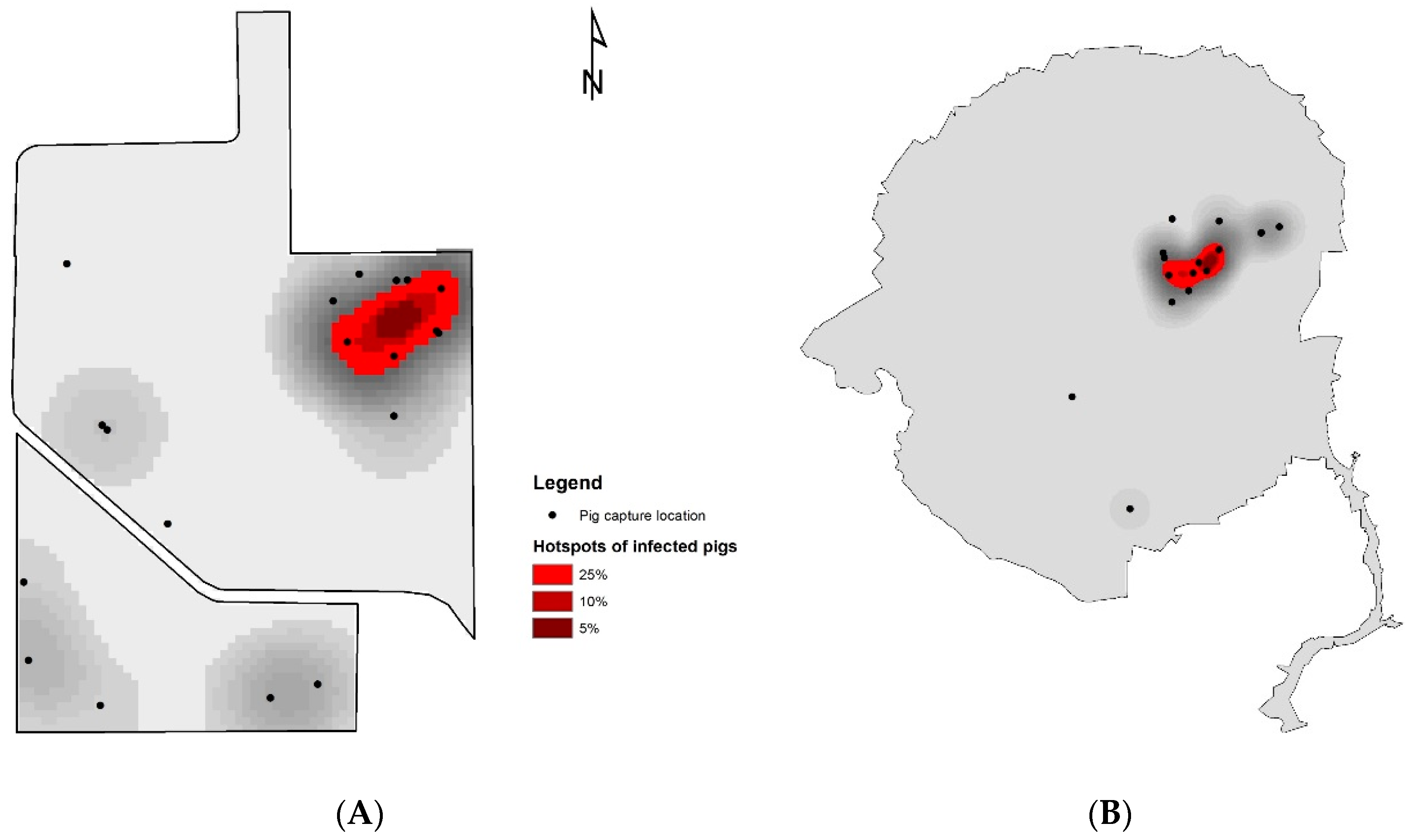

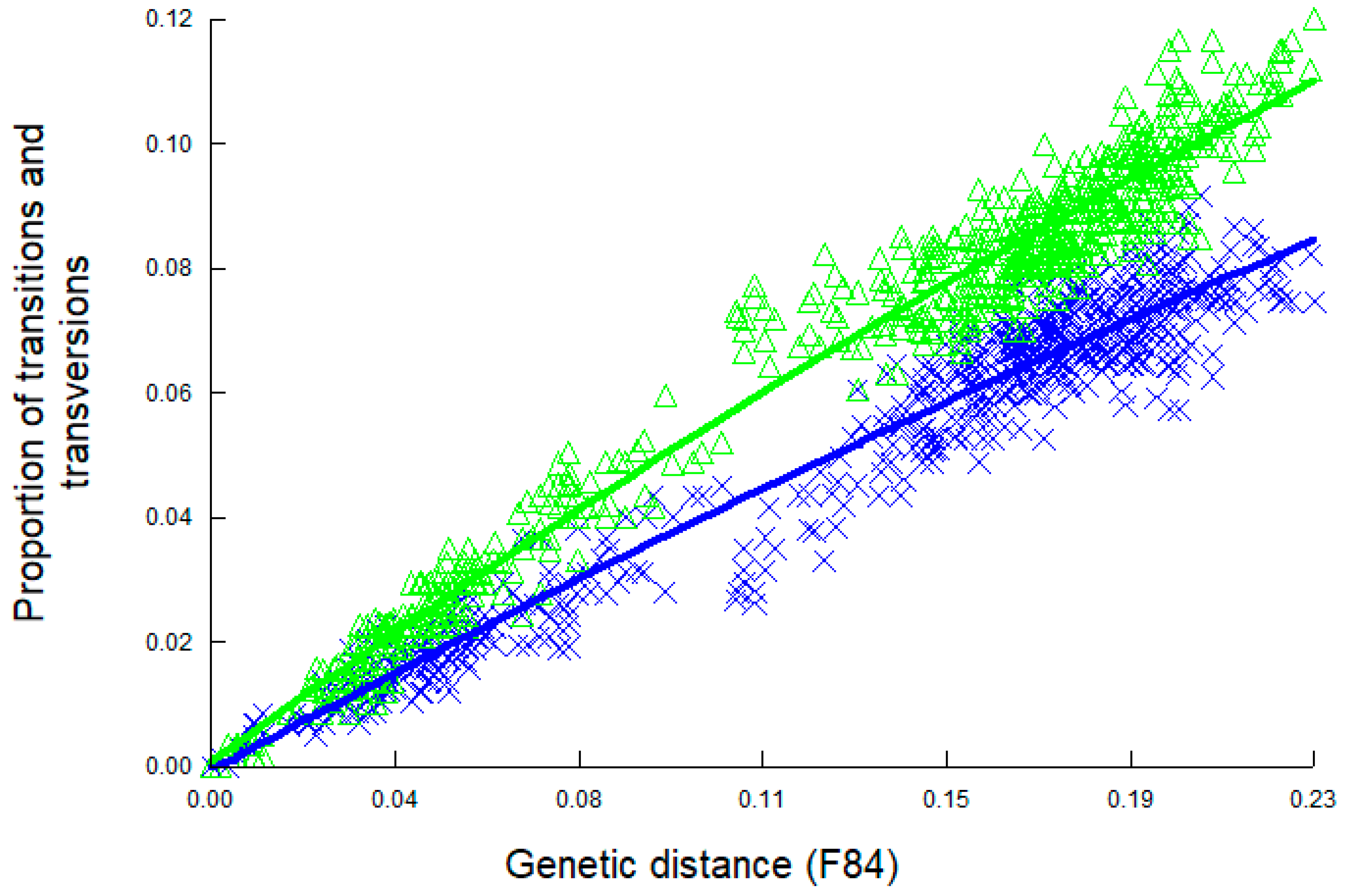
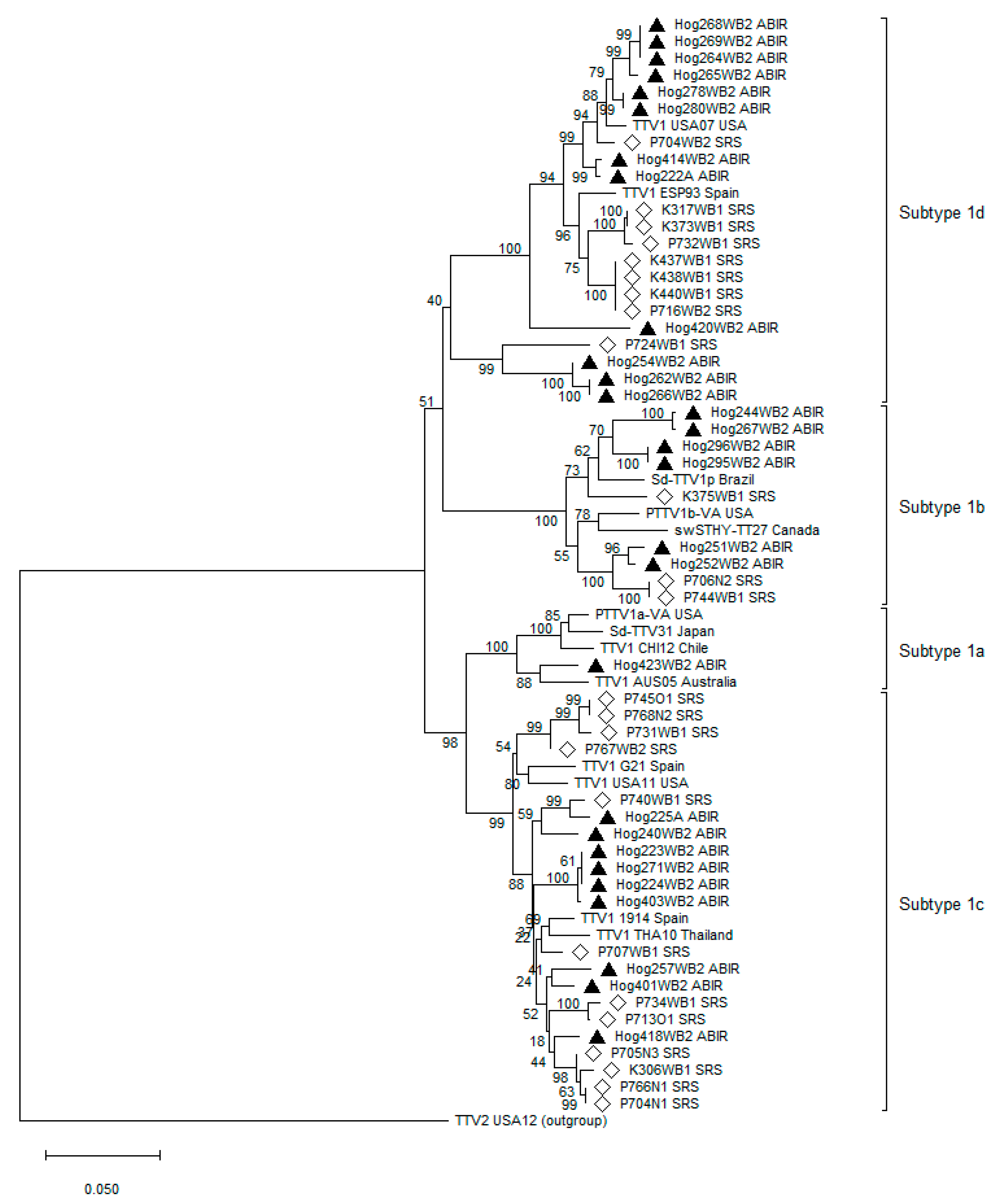
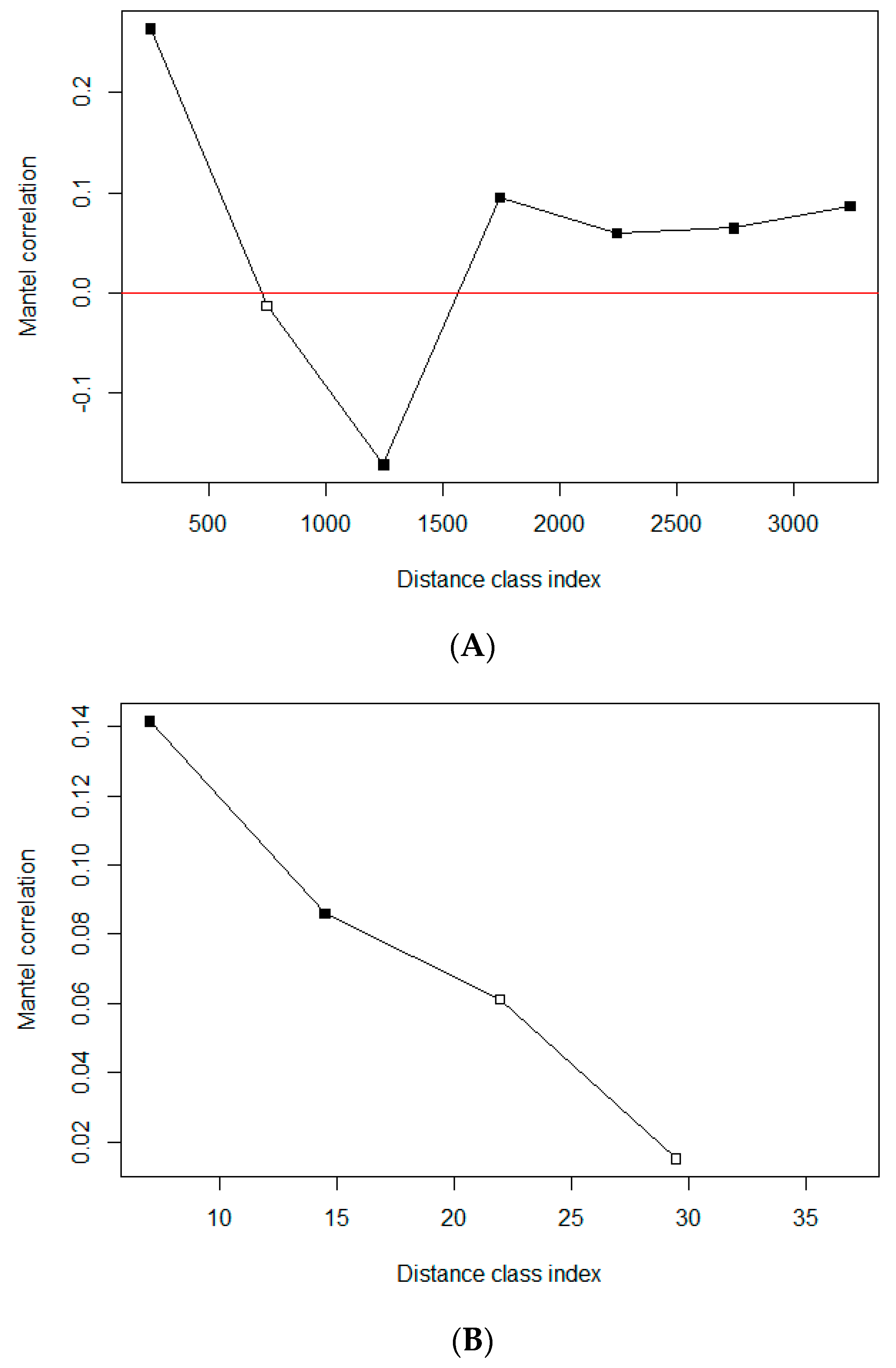
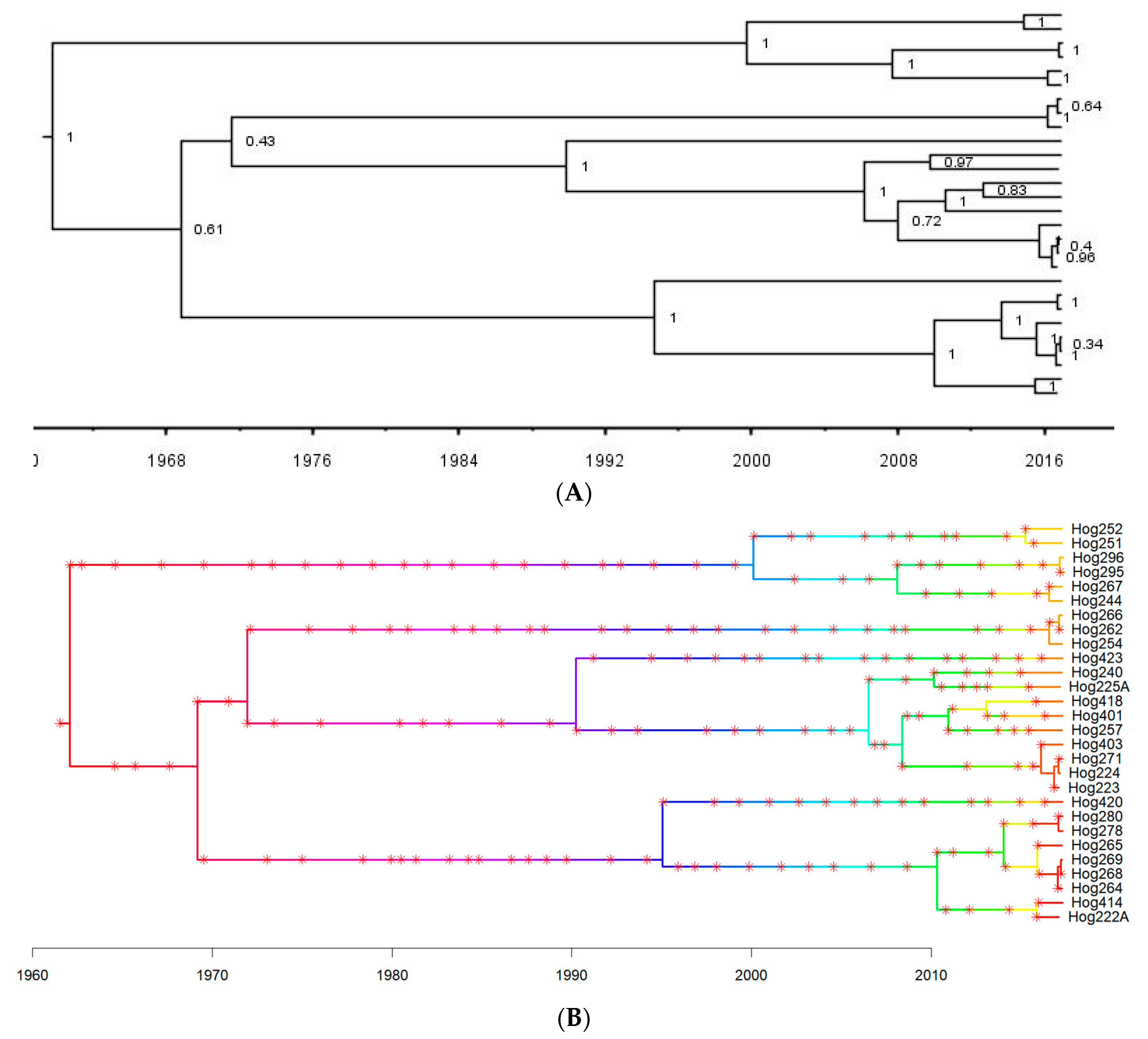
| Site | Body Measurement | Description | Correlation to Body Mass $ |
|---|---|---|---|
| ABIR * | Neck circumference | Circumference at neck | 0.926 |
| Chest Girth | Girth just behind forelegs | 0.968 | |
| Wither length | Girth just in front of back legs | 0.934 | |
| Body length | Base of tail to base of ears | 0.900 | |
| Total length | Base of tail to tip of nose | 0.898 | |
| SRS # | Chest Girth | Girth behind forelegs | 0.936 |
| Total length | Base of tail to tip of nose | 0.939 |
| Site | Sample Type | |||||
|---|---|---|---|---|---|---|
| Blood | Oral | Nasal | Genital | Total | ||
| No. | 97 | 102 | 102 | 100 | 102 | |
| ABIR | Positive #* | 40 | 0 | 0 | 0 | 40 |
| Prevalence $ | 41.2% a (31.9–51.1%) | 0.0% a (0–3.6%) | 0.0% a (0–3.6%) | 0.0% a (0–3.7%) | 39.2% a (30.3–48.9%) | |
| No. | 87 | 88 | 88 | 88 | 88 | |
| SRS | Positive # | 32 | 6 | 6 | 1 | 34 |
| Prevalence | 36.8% a (27.4–47.3%) | 6.8% b (3.2–14.1%) | 6.8% b (3.2–14.1%) | 1.1% a (1.9–6.1%) | 38.6% a (29.1–49.0%) | |
| Sample ID | Sex | Age | Infectee | Sex | Age | Distance (m) | Relatedness |
|---|---|---|---|---|---|---|---|
| hog296 | Male | 2Y | hog295 | Female | 2Y | 911.3 | 0.0006 |
| hog244 | Female | 3Y | hog267 | Female | 1Y | 653.6 | 0.08 |
| hog266 | Female | 1Y | hog262 | Male | 1Y | 0 | 0.23 |
| hog254 | Male | 1Y | hog266 | Female | 1Y | 1450.3 | 0.01 |
| hog224X | Female | 1Y | hog271 | Female | 1Y | 0 | 0.48 |
| hog224X | Female | 1Y | hog223X | Female | 2Y | 0 | 0.53 |
| hog224X | Female | 1Y | hog403 | Female | 1Y | 660.1 | 0.09 |
| hog278 | Female | 2Y | hog280 | Male | 3M | 0 | 0.15 |
| hog269 | Female | 1Y | hog268 | Female | 1Y | 0 | 0.45 |
| hog269 | Female | 1Y | hog264 | Male | 1Y | 0 | 0.45 |
Disclaimer/Publisher’s Note: The statements, opinions and data contained in all publications are solely those of the individual author(s) and contributor(s) and not of MDPI and/or the editor(s). MDPI and/or the editor(s) disclaim responsibility for any injury to people or property resulting from any ideas, methods, instructions or products referred to in the content. |
© 2024 by the authors. Licensee MDPI, Basel, Switzerland. This article is an open access article distributed under the terms and conditions of the Creative Commons Attribution (CC BY) license (https://creativecommons.org/licenses/by/4.0/).
Share and Cite
Li, X.; Parker, B.M.; Boughton, R.K.; Beasley, J.C.; Smyser, T.J.; Austin, J.D.; Pepin, K.M.; Miller, R.S.; Vercauteren, K.C.; Wisely, S.M. Torque Teno Sus Virus 1: A Potential Surrogate Pathogen to Study Pig-Transmitted Transboundary Animal Diseases. Viruses 2024, 16, 1397. https://doi.org/10.3390/v16091397
Li X, Parker BM, Boughton RK, Beasley JC, Smyser TJ, Austin JD, Pepin KM, Miller RS, Vercauteren KC, Wisely SM. Torque Teno Sus Virus 1: A Potential Surrogate Pathogen to Study Pig-Transmitted Transboundary Animal Diseases. Viruses. 2024; 16(9):1397. https://doi.org/10.3390/v16091397
Chicago/Turabian StyleLi, Xiaolong, Brandon M. Parker, Raoul K. Boughton, James C. Beasley, Timothy J. Smyser, James D. Austin, Kim M. Pepin, Ryan S. Miller, Kurt C. Vercauteren, and Samantha M. Wisely. 2024. "Torque Teno Sus Virus 1: A Potential Surrogate Pathogen to Study Pig-Transmitted Transboundary Animal Diseases" Viruses 16, no. 9: 1397. https://doi.org/10.3390/v16091397





